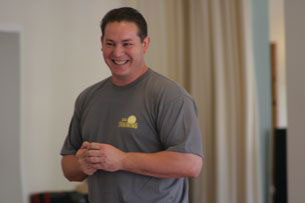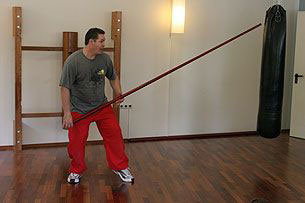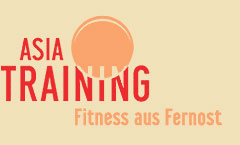Please just call me Scott.
Would you please tell us how you started of with Martial Arts, Wing Chun specifically?
I became interested when I was around twelve years old when I saw the Kung Fu TV show with David Carradine. I began looking into the martial arts, and learned about Wing Chun through a Martial Arts supply where I would buy books and magazines.
It turned out that the owner was himself a Wing Chun Sifu by the name of Peter Yu; he invited me to observe Master Tam Hun Fun who was visiting him from Hong Kong; from there I was hooked.
Why do Wing Chun and Chi-Kung in your opinion belong together? Does an effective Self-Defense-System need any Chi-Kung at all?
Wing Chun is a very effective system, structurally it is designed for combat, both in its physical make up, its concepts and principles, and its internal aspects. Wing Chun is designed to be an internal system, when trained correctly many develop some degree of internal skill without being aware of it. Once one “unlocks” this deeper side of the art one can see clearly that the whole system is designed to bring out the use of the Chi (qu) that is innate in every living thing. Wing Chun and Chi (Qu) Kung belong together because Wing Chun was designed as an energy based system. The legends of a young girl (Yim Wing Chun) defeating a larger skillful man after only a few months of training are classical signs of the fundamental internal nature of this style. Now like say Aikido, Wing Chun does not have to have its internal skills taught to be effective. Aikido is an effective system for controlling a person, which is why in the USA they teach it to police officers. The police use it effectively without ever knowing the Ki (internal) side of the system. But if you ever see a real master of Aikido use the internal side of the art you will see it can be much more than a few simple locks and techniques.
The same is true of Wing Chun, it is effective as a fighting system without the internal skills, it is far more effective however once one learns to master the internal side. There is an old proverb that reflects this, in Chinese they say: “Lin Kyun but lin gong, Dou Lou yat cheung Hong” (To practice the forms but not the Gong (Internal or Chi Kung), when you are old your Kung Fu will be empty).
The Chi Kung training is a fundamental part of Wing Chun, and the old masters who are still able to defeat the young are only able to because they have the Gong (internal training) within their skills. In my opinion if you are learning Wing Chun without the internal skills, you are learning a young man’s art, and as the saying goes, once you are old your Wing Chun will be empty. The internal side is essential for keeping the skills into old age; also it is essential for women and the small or weaker among us if they truly and realistically want to have skills that will defeat a larger stronger attacker.
What is it that any given person can get out of Wing Chun/Chi-Kung training besides the self defense aspect?
There are all sorts of benefits for doing the internal training. Other than improving the root (stance strength) and learning to apply the releasing skills and the sensing skills that Chi Kung training gives you, you will benefit from learning to control your mind, quite the chatter and be in the moment, calm and control ones breathing, relax and feel deep with your body to release stress and tension, focus your mind powerfully, improve your health and many other side effects.
However, Wing Chun is an inherently practical art, and the focus of the Chi Kung in Wing Chun is the practical combat applications, which is the focus of my book, and of the seminars I teach.
Is Wing Chun really working for women as often advertised?
Well which Wing Chun? Sadly some are teaching and practicing Wing Chun Karate! They use tension and physical size to generate power, this is not the Wing Chun way, and this type of Wing Chun will not work well for women, older people and smaller framed people, in fact it only works for those who are larger and stronger than their opponents. And then it works only if their opponents do not possess any real skills themselves. Soft internal Wing Chun does work, it generates power and strength from a different paradigm than the harder fighting systems more suited to the large, young and strong. But it requires a unique discipline to obtain competent skills; one will have to put persistent effort over time to gain the returns they seek. There is no easy path to real skill, after all Kung Fu does mean: a skill acquired through hard work.
There is a lot of talk about ‘original’ Wing Chun, ‘authentic’ Wing Chun, the ‘original’ dummy and weapons forms and so on. What is your opinion on that matter?
It is a bunch of marketing hype! Anyone who really understands the art will know that the order one plays the forms and sets in the system is irrelevant so long as they still contain the key concepts and principles that make Wing Chun what it is.
All the great masters from the very beginning have made adjustments to how they teach and practice the forms and sets, most of them made no secret to that fact. The art is a living thing, it grows and evolves with society , with the insights and needs of the masters of the time. From the famed Leung Jan, through to Yip Man himself, all made changes to the forms. The great Yuen Kay-San, perhaps the first in history to record everything he was taught made changes that he documented as he taught his only disciple Sum Num. And the great master Sum Num was clear about things he adjusted and changed when he taught the forms to his students.
The dummy and weapons are to teach principles and concepts of moving and fighting, so long as these keys are taught within the sets one learns, then you have the original set. The outward pattern or sequence is not important, it is the inward applications and understanding of how to use the weapons and apply the dummy skills that matter.
What is the importance of the wooden dummy and the weapons in Wing Chun, and how soon should they be taught?
They build upon the empty hand sets and skills to bring your Kung Fu to a higher level. The dummy is important for teaching how to use your power, how to release into something tangible, how to unlock the keys in the empty hand sets by working them off the dummy.
The pole teaches some essential keys about generation of power, using the body mechanics to control and power the weapon. It also deepens the energy skills, it changes the tendons and ligaments in the body to be even better suited for allowing the energy or chi to transfer through them.
The knives add to this, and further develop the releasing skills, focusing in the wrists and forearms.
The weapons and dummy should be taught once the basic structures and motions taught in the first three forms are able to be done with a good level of ability, and then the student can benefit from the deepening effects of the dummy and the weapons.
How long should it take approximately to learn all the techniques, all the forms of Wing Chun? Assuming an average student, training two to three times a week, how long should it take to learn "the System" ?
In my experience a diligent student with the drive to practice at home as well as during class can easily complete the whole system within 8 to 10 years. Now from there it will take many decades to master the system. So completing the system up through the knives is the beginning of mastery, not the end.
How did you get to visit Germany and hold your first seminar in Europe at Asia Training, Munich?
Well that’s a fun story. I was contacted by two nice guys who had purchased a copy of my book. They had some good questions and I could tell had open minds and a desire to learn. Both were already quite skilled in the basic structures and physical skills of Wing Chun, so they were looking for a deeper path.
They took the time and effort to travel to the USA to visit me. We trained together for 3-5 days, I do not recall the exact time frame. They went back and started Asia Training together. Then they arranged for me to come and see them, I agreed and that’s how it happened. I found that the Asia Training teachers and students personify all the best qualities and characteristics of a good martial art school. The people are all very friendly and respectful to each other. The teachers are skilled, they really teach quality skills, and are gifted at being able to teach all age groups, a skill that I rarely find anywhere! I watched many classes, and enjoyed the fact that they all have fun learning and training together; that’s the way Wing Chun is meant to be taught! In a fun relaxed atmosphere, without fear, without ego, without political and emotional manipulation. I hope to see Asia Training become a huge success in Munich, and throughout Germany and Europe!
Thank you for this interview, Sifu Scott.
You are very welcome.
By the way, what do you think of Germany, did you enjoy your stay? You probably didn’t see a lot, teaching at Asia Training every day.
I loved Germany, the people were all very friendly, down to earth people, my kind of people. I loved the culture, the beer, and most of all the people. I didn’t need to see a lot, I saw Munich and I saw in the people of Munich kindness, friendliness and genuineness. It doesn’t get better than that!


